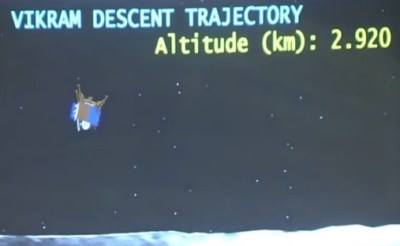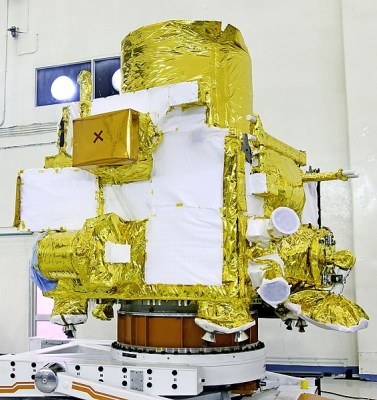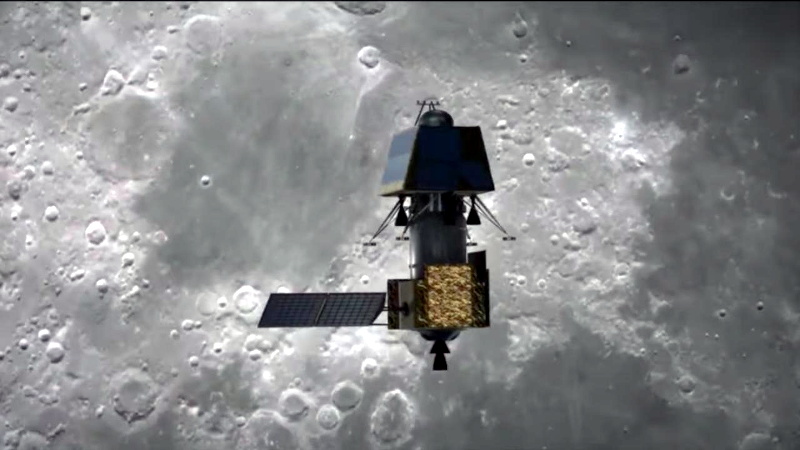India’s Chandrayaan-2 mission to the Moon was, in a word, ambitious. Lifting off from the Satish Dhawan Space Centre on July 22nd, the mission hoped to simultaneously deliver an orbiter, lander, and rover to our nearest celestial neighbor. The launch and flight to the Moon went off without a hitch, and while there were certainly some tense moments, the spacecraft ultimately put itself into a stable lunar orbit and released the free-flying lander so it could set off on its independent mission.
Unfortunately, just seconds before the Vikram lander touched down, an anomaly occurred. At this point the Indian Space Research Organisation (ISRO) still doesn’t know exactly what happened, but based on the live telemetry stream from the lander, some have theorized the craft started tumbling or otherwise became unstable between three and four kilometers above the surface.

In fact, for a brief moment the telemetry display actually showed the Vikram lander completely inverted, with engines seemingly accelerating the spacecraft towards the surface of the Moon. It’s unclear whether this was an accurate depiction of the lander’s orientation in the final moments before impact or a glitch in the real-time display, but it’s certainly not what you want to see when your craft is just seconds away from touchdown.
But for Chandrayaan-2, the story doesn’t end here. The bulk of the mission’s scientific goals were always to be accomplished by the orbiter itself. There were of course a number of scientific payloads aboard the Vikram lander, and even the Pragyan rover that it was carrying down to the surface, but they were always secondary objectives at best. The ISRO was well aware of the difficulties involved in making a soft landing on the Moon, and planned their mission objectives accordingly.
Rather than feel sorrow over the presumed destruction of Vikram and Pragyan, let’s take a look at the scientific hardware aboard the Chandrayaan-2 orbiter, and the long mission that still lies ahead of it.
Long Term Goals
The Chandrayaan-2 orbiter is an evolved version of the spacecraft the ISRO launched to the Moon in 2008 during the Chandrayaan-1 mission. The 682 kg (1,504 lb) craft is a bit longer than your average midsize car, and was designed for a nominal mission length of one year. But given the accuracy with which the craft was placed into its 100 km polar orbit around the Moon, mission planners are now hopeful the craft will remain stable for much longer, perhaps as many as six years longer than originally estimated.

While the orbiter was responsible for bringing the Vikram lander to the Moon, that was never its primary goal. According to ISRO Chairman Kailasavadivoo Sivan, approximately 90-95% of the scientific goals of the mission were always to be accomplished by the orbiter itself. The loss of the lander and rover were certainly unfortunate, but the impact on overall mission success is considered minimal.
Somewhat ironically, the scientific instruments aboard the orbiter have already been put to good use trying to locate the Vikram lander on the surface. One of the most important pieces of equipment on the orbiter is the Orbiter High Resolution Camera (OHRC), which is capable of 30 centimeters per pixel resolution; slightly edging out NASA’s Lunar Reconnaissance Orbiter in terms of its ability to resolve surface details.
The orbiter also has the Terrain Mapping Camera-2 (TMC-2), a 3D imager which will create a detailed height-map of the lunar surface. Combined with data collected by the orbiter’s ground penetrating synthetic-aperture radar and X-ray spectrometer, Chandrayaan-2 will be able to create a map of the Moon that not only pinpoints potential deposits of subsurface water ice, but provides the terrain detail necessary for future missions to plan their landing.
Surface scanning and mapping will be one of the major priorities as Chandrayaan-2 embarks on its extended mission, but it will also be doing science in the Moon’s tenuous and largely unexplored atmosphere. A quadrupole mass analyzer aboard the orbiter will analyze the composition of the exosphere, and there’s also a radio experiment to study the electron density of the ionosphere.
Determining Vikram’s Fate
While no images have been released to the public as of yet, the ISRO has confirmed that the high resolution camera aboard the Chandrayaan-2 orbiter was able to locate the Vikram lander on the surface. With a resolution of 0.3 meter/pixel, the 2.54 meter wide lander would only show up in images as a small blotch, but apparently that’s enough for the agency to determine that the craft appears to be intact and sitting at an angle. In light of this, the ISRO is currently attempting to make contact with Vikram in the hopes that it somehow survived the hard landing.

To be sure, it’s exceptionally unlikely that Vikram will respond to their hails. Some estimates have pointed to a potential impact velocity of better than 100 meters per second, and even if the vehicle’s crumpling structure was able to absorb that amount of energy, the damage to the internal instrumentation was likely catastrophic. Beyond damage sustained during impact, the simple fact that the lander isn’t sitting level could be enough to complicate communications. Antenna alignment is a delicate operation, and unexpected changes to a spacecraft’s orientation can easily prevent it from establishing a link to ground control.
In any event, the clock is ticking. The lander’s touchdown on the surface was planned to coincide with the start of the lunar day, the two-week long period where the Sun is high enough above the horizon to provide the craft with warmth and power. Once the light fades and the temperatures plummet, Vikram’s chances of survival are effectively zero. If potentially one of the greatest comeback stories in the history of space exploration is going to happen, it’ll need to happen very soon.
















I think they ‘know’ what happened by now, but national pride is at stake, and it is best to release the news on a proverbial Friday before a holiday weekend.
” At this point the Indian Space Research Organisation (ISRO) still doesn’t know exactly what happened, but based on the live telemetry stream from the lander, some have theorized the craft started tumbling or otherwise became unstable between three and four kilometers above the surface.”
And either ended upside down, or right side up? Latter, if one’s commenting about antenna orientation. The fortuitous luck of a proverbial cat landing on it’s feet.
Maybe they should include a cat, attached to the position control systems, in next missions ….Maybe it would help the rockets to try to land in the correct orientation …
there are videos of cats in a microgravity enviroment…they don’t do so well…
Even buttered toast would fail the “down” test.
Let’s not forget that the cat is both dead, and alive – until it is observed as one or the other.
It definitely seems possible the lander is upside-down. With the res of the camera, there would be no way to tell. The difference between it being horizontal and vertical in the images is literally a pixel or two. Anything else is just a guess.
If you want to see the live telemetry there is a video here…
https://www.youtube.com/watch?v=2F5ujdCvJRU
Damn….that’s dark.
Thats hurtful man lol https://www.youtube.com/watch?v=LowVhCfLm68
This is how you land on the Moon. https://youtu.be/v0yfz5g_Kxc?t=15
Yes but the Chinese mission to the Moon found something they did not expect and can not figure out. It is the glue used to fasten a patch to the Moon.
Lot of detail is still unreleased. But from open information few of the point:
– Till around 2.1 KM everything was ‘normal’ so above orientation is either a graphic representation anomaly/missing orientation data at ground station or within normal parameter.
– At 2.1 KM it deviation from trajectory is observed. Now Vikram was an autonomous system which was suppose to continuously scan the landing site and determine if landing here is ok or not. If not it was to move away from there and find a new site. I can’t say at what point it was suppose to move away, but given the Vikram’s parameter, moving away from exact spot was expected.
– Telemetry was healthy till 335 meters of altitude (against a media hyped 2.1 KM) with a little higher descend speed and good orientation. What happened after that remains unsolved (without any data being received, I doubt ISRO actually knows and is hiding anything here.)
My guess is, Vikram determined that it need to hover (and perhaps move further away) at which point one of the attitude control thruster either gave over or under thrust causing it to tumble and main engine which was firing at that point ensured that Vikram became a bullet toward surface. Instantly damaging everything including any telemetry after 335 meters. Chance of sabotage…. need some conspiracy theory writers (not by aliens, but by a rogue signal from neighborhood of India or an intentional bug.)
My best guess so far has also been a stuck attitude thruster- however, the spin didn’t seem to be accelerating (looking at the RF doppler shift from amateur observers, Scott Manley’s video) which means a stuck thruster was unstuck, or quickly ran out of propellant. Could always be good ol’ stack overflow.
What might be interesting to note regarding the importance of an accurate orbit:
“But given the accuracy with which the craft was placed into its 100 km polar orbit around the Moon, mission planners are now hopeful the craft will remain stable for much longer, perhaps as many as six years longer than originally estimated.”
The moons gravity field is not uniform. It is very lumpy, which causes disturbances in otherwise stable orbits, leading to the orbit decaying or shifting. By picking an orbit where all the lumps and bumps in the gravity field even out over the course of the orbit you can achieve a longer on orbit time before the orbit starts shifting. The more accurate you can get your spacecraft into exactly that orbit, the longer it’ll stay up there.
Above a certain altitude (approximately 100 kilometers) the gravity lumps don’t matter so much, but then the orbital speed is much lower. The stable low altitude orbits are called “frozen orbits”. That they existed, and that other inclinations at the same altitude were unstable, were accidentally discovered during the Apollo 15 and 16 missions. Two small satellites, PFS-1 and PFS-2 were put into orbit around the Moon. PFS-1 from Apollo 15 went into an inclination of 28 degrees while PFS-2 from Apollo 16 went into an inclination of 11 degrees.
PFS-1 lasted from August 4, 1971 until January 1973 when it suffered multiple electronic failures. It’s unknown how much longer it stayed in orbit. PFS-2’s orbit quickly began to rapidly change shape and altitude, at one point it swooped to within 6 miles of the Lunar surface. Then it backed off to an altitude of 30 miles before creeping closer and closer until it impacted only 35 days after launch.
PFS-1’s orbit just happened to be only one degree off the 27 degree frozen orbit inclination where the various pulls from the masscons cancel out.
For quite a while it was thought there were only 3 frozen Lunar orbits at 27, 50, and 76 degrees, then the fourth one at 86 degrees was discovered. That’s likely the inclination the Indians aimed to get their orbiter into.
Given my experience with code from the subcontinent, I’m more surprised by the display of sequential non-failures than anything else.
Ya you get what you pay for.
The attempt could have been executed with complete perfection yet have as little as a cosmic ray striking the wrong transistor in a memory array cause this. There is never a guarantee of success in the physical world.